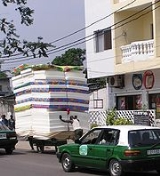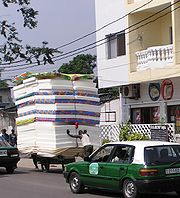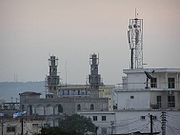
Poto-Poto
Encyclopedia
Poto-Poto is the name of one of the original residential neighborhoods of the city of Brazzaville
, capital of the Republic of Congo.

colonizers in 1909, to the northeast of the central part of town (simply called la ville in French) which was reserved for white residents only. Meanwhile, to the southwest, the neighborhood of Bacongo was also established. The French founded both Poto-Poto and Bacongo in order to create residential zones for the African workers who had begun flocking to the growing city. Initially, Bacongo drew migrants from the southern part of the colony, while Poto-Poto was settled by migrants from the north and central regions, as well as by immigrants from other African colonies, including Chad
, Oubangui-Chari
(now the Central African Republic
) and various parts of West Africa. In fact, the name Poto-Poto comes from the word in the Bambara language
meaning "watery mud"—so named because the neighborhood is located in a low-lying area which tends to flood during heavy rains. Still today, streets in Poto-Poto reflect the diverse origins of the neighborhood's inhabitants: they bear the names of distant places (e.g. Rue Dahomey
, Rue Yaounde
) and of ethnic groups (e.g. Rue Bateke
, Rue Zande
, Rue Mbochi
). Within five years of its founding, Poto-Poto was subdivided by colonial authorities into units organized by common ethnicity, and quickly became the most densely populated section of the city.
In 1959, during the run-up to decolonization, Poto-Poto was the scene of violence which touched off a major political conflict between northern and southern Congolese and which soon engulfed all of Brazzaville. During the June–October 1997 civil war, Poto-Poto was thoroughly looted by "Cobra" militiamen loyal to opposition leader Denis Sassou Nguesso
and was shelled by forces loyal to President Pascal Lissouba
.
Poto-Poto is one of Brazzaville's seven arrondissements or administrative districts.
border Poto-Poto to the south. To the north lies the district of Moungali, an extension of the arrondissement of Poto-Poto (sometimes referred to as "Poto-Poto Deux") but in recent decades a large and mostly residential neighborhood in its own right. Poto-Poto is bordered on the east by the residential neighborhood of Ouenzé
, and on the west by the government/commercial zone known as le Plateau.
 Poto-Poto is home to the Sainte-Anne Basilica, a large Catholic church which sits near the intersection of Avenue de la Paix and Avenue de France. It was constructed during the late colonial era with brick walls and a green tiled roof, and was consecrated in 1949. Directly across the roundabout from the Basilica is the Maison du Peuple, the seat of local government. The center of the neighborhood is dominated by a market, one of Brazzaville's largest. Since the 1990s Poto-Poto, like most other neighborhoods of Brazzaville, has been home to numerous small but boisterous evangelical churches of all denominations. There are also at least six mosques, including the Masjid al-Sunna (or Sunni Mosque) on Rue Bacongo, which is the largest mosque in Congo and holds nearly 2000 worshippers; its construction was entirely financed by members of Brazzaville's West African immigrant population. Finally, the Hotel Marimar (named for a popular 1994 Mexican telenovela starring Thalía
Poto-Poto is home to the Sainte-Anne Basilica, a large Catholic church which sits near the intersection of Avenue de la Paix and Avenue de France. It was constructed during the late colonial era with brick walls and a green tiled roof, and was consecrated in 1949. Directly across the roundabout from the Basilica is the Maison du Peuple, the seat of local government. The center of the neighborhood is dominated by a market, one of Brazzaville's largest. Since the 1990s Poto-Poto, like most other neighborhoods of Brazzaville, has been home to numerous small but boisterous evangelical churches of all denominations. There are also at least six mosques, including the Masjid al-Sunna (or Sunni Mosque) on Rue Bacongo, which is the largest mosque in Congo and holds nearly 2000 worshippers; its construction was entirely financed by members of Brazzaville's West African immigrant population. Finally, the Hotel Marimar (named for a popular 1994 Mexican telenovela starring Thalía
) rises majestically above Avenue de la Paix and welcomes a discerning clientele from throughout the city, most of whom arrive without luggage and do not spend the night. Pockmarks in the Hotel's facade left by bullets and rocket-propelled grenades, reminders of the 1997 civil war, were finally cemented over in 2005 at the behest of the government. Poto-Poto's denizens may also partake of various varieties of nightlife in the neighborhood's famous bars and clubs, including Chez Faignond which was one of the first Congolese-owned nightspots, established in 1948. The Ecole de Peinture de Poto-Poto (Poto-Poto School of Painting), though technically located in Moungali, is a renowned artistic centre which has produced numerous artists with a distinctive visual style.
Brazzaville
-Transport:The city is home to Maya-Maya Airport and a railway station on the Congo-Ocean Railway. It is also an important river port, with ferries sailing to Kinshasa and to Bangui via Impfondo...
, capital of the Republic of Congo.

History
Poto-Poto was originally demarcated by FrenchFrance
The French Republic , The French Republic , The French Republic , (commonly known as France , is a unitary semi-presidential republic in Western Europe with several overseas territories and islands located on other continents and in the Indian, Pacific, and Atlantic oceans. Metropolitan France...
colonizers in 1909, to the northeast of the central part of town (simply called la ville in French) which was reserved for white residents only. Meanwhile, to the southwest, the neighborhood of Bacongo was also established. The French founded both Poto-Poto and Bacongo in order to create residential zones for the African workers who had begun flocking to the growing city. Initially, Bacongo drew migrants from the southern part of the colony, while Poto-Poto was settled by migrants from the north and central regions, as well as by immigrants from other African colonies, including Chad
Chad
Chad , officially known as the Republic of Chad, is a landlocked country in Central Africa. It is bordered by Libya to the north, Sudan to the east, the Central African Republic to the south, Cameroon and Nigeria to the southwest, and Niger to the west...
, Oubangui-Chari
Oubangui-Chari
Oubangui-Chari, or Ubangi-Shari, was a French territory in central Africa which later became the independent Central African Republic . French activity in the area began in 1889 with the establishment of an outpost at Bangui, now the capital of CAR. The territory was named in 1894.In 1903, French...
(now the Central African Republic
Central African Republic
The Central African Republic , is a landlocked country in Central Africa. It borders Chad in the north, Sudan in the north east, South Sudan in the east, the Democratic Republic of the Congo and the Republic of the Congo in the south, and Cameroon in the west. The CAR covers a land area of about ,...
) and various parts of West Africa. In fact, the name Poto-Poto comes from the word in the Bambara language
Bambara language
Bambara, more correctly known as Bamanankan , its designation in the language itself , is a language spoken in Mali by as many as six million people...
meaning "watery mud"—so named because the neighborhood is located in a low-lying area which tends to flood during heavy rains. Still today, streets in Poto-Poto reflect the diverse origins of the neighborhood's inhabitants: they bear the names of distant places (e.g. Rue Dahomey
Dahomey
Dahomey was a country in west Africa in what is now the Republic of Benin. The Kingdom of Dahomey was a powerful west African state that was founded in the seventeenth century and survived until 1894. From 1894 until 1960 Dahomey was a part of French West Africa. The independent Republic of Dahomey...
, Rue Yaounde
Yaoundé
-Transportation:Yaoundé Nsimalen International Airport is a major civilian hub, while nearby Yaoundé Airport is used by the military. Railway lines run west to the port city of Douala and north to N'Gaoundéré. Many bus companies operate from the city; particularly in the Nsam and Mvan neighborhoods...
) and of ethnic groups (e.g. Rue Bateke
Bateke
The Bateke are a Central African ethnic group that speak the Teke languages. Its population is situated mainly in the Democratic Republic of the Congo, the Republic of the Congo and with a minority in Gabon...
, Rue Zande
Zande
Zande may refer to:* A variant spelling of Azande, a people of north central Africa* Zande language, the language of the Azande people* Zande, Belgium* Xande, Zande in the NES fan translation, a major antagonist of Final Fantasy III...
, Rue Mbochi
Mbochi
The Mbochi are a central African ethnic group whose population is concentrated in the northern region of the Republic of the Congo. The current Congolese president, Denis Sassou-Nguesso, as well as many senior government officials, belong to this group....
). Within five years of its founding, Poto-Poto was subdivided by colonial authorities into units organized by common ethnicity, and quickly became the most densely populated section of the city.
In 1959, during the run-up to decolonization, Poto-Poto was the scene of violence which touched off a major political conflict between northern and southern Congolese and which soon engulfed all of Brazzaville. During the June–October 1997 civil war, Poto-Poto was thoroughly looted by "Cobra" militiamen loyal to opposition leader Denis Sassou Nguesso
Denis Sassou Nguesso
Denis Sassou Nguesso is a Congolese politician who has been the President of Congo-Brazzaville since 1997; he was previously President from 1979 to 1992. During his first period as President, he headed the single-party regime of the Congolese Labour Party for 12 years...
and was shelled by forces loyal to President Pascal Lissouba
Pascal Lissouba
Pascal Lissouba was the first democratically elected President of the Republic of the Congo from August 31, 1992 to October 15, 1997. He was overthrown by the current President Denis Sassou Nguesso in the 1997 civil war....
.
Poto-Poto is one of Brazzaville's seven arrondissements or administrative districts.
Geography
The neighborhood is cross-cut by two main paved arteries, Avenue de la Paix which runs north-south and Avenue de France which runs east-west. Nearly every other street in Poto-Poto is unpaved; most are called ruelles (alleyways) in French. The railyards of the Congo-Ocean RailwayCongo-Ocean Railway
The Congo–Ocean Railway links the Atlantic port of Pointe-Noire with Brazzaville, a distance of 502 kilometres...
border Poto-Poto to the south. To the north lies the district of Moungali, an extension of the arrondissement of Poto-Poto (sometimes referred to as "Poto-Poto Deux") but in recent decades a large and mostly residential neighborhood in its own right. Poto-Poto is bordered on the east by the residential neighborhood of Ouenzé
Ouenze
Ouenzé is one of the arrondissements of Brazzaville, capital of Republic of Congo. It is located in the north of the capital. Brazzaville is divided into seven arrondissements, or districts: Makélékélé , Bacongo , Poto-Poto , Moungali , Ouenzé , Talangaï and Mfilou .There are many sports like...
, and on the west by the government/commercial zone known as le Plateau.
Notable features

Thalía
Ariadna Thalía Sodi Miranda , known simply by the mononym Thalía , is a Mexican singer and actress. She has sold over 40 million albums worldwide...
) rises majestically above Avenue de la Paix and welcomes a discerning clientele from throughout the city, most of whom arrive without luggage and do not spend the night. Pockmarks in the Hotel's facade left by bullets and rocket-propelled grenades, reminders of the 1997 civil war, were finally cemented over in 2005 at the behest of the government. Poto-Poto's denizens may also partake of various varieties of nightlife in the neighborhood's famous bars and clubs, including Chez Faignond which was one of the first Congolese-owned nightspots, established in 1948. The Ecole de Peinture de Poto-Poto (Poto-Poto School of Painting), though technically located in Moungali, is a renowned artistic centre which has produced numerous artists with a distinctive visual style.
Sources
- Balandier, Georges. (1985) Sociologie des Brazzavilles Noires. 2nd edition. Paris: Presses de la Fondation Nationale des Sciences Politiques.
- Martin, Phyllis M. (1995) Leisure and Society in Colonial Brazzaville. New York: Cambridge University Press.
Further reading
- Croce-Spinelli, Michel. (1982) Les Enfants de Poto-Poto. Paris: Harmattan.

